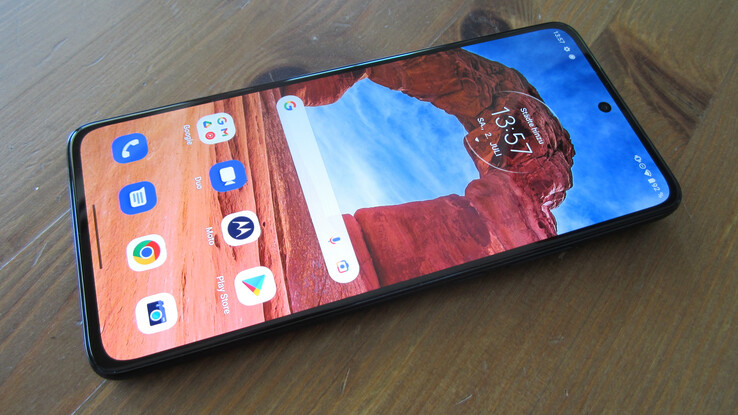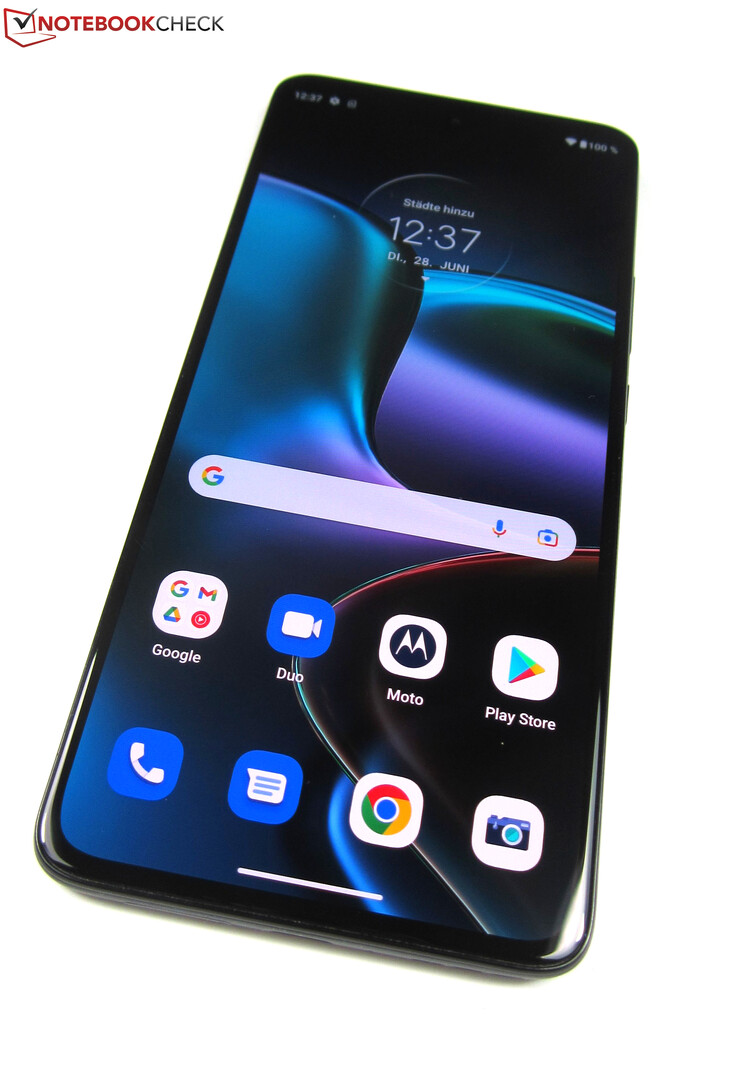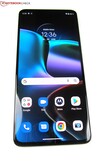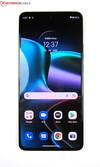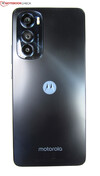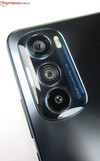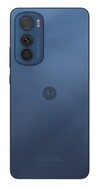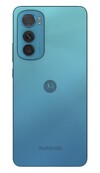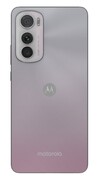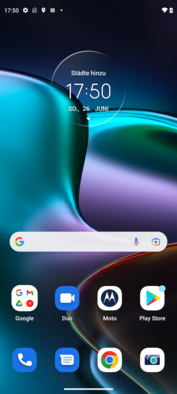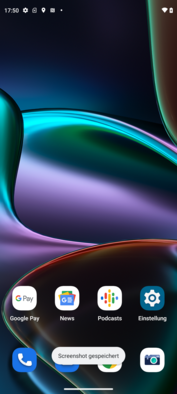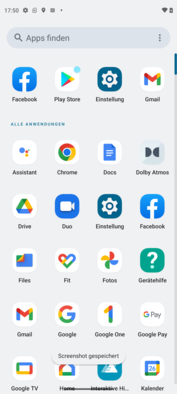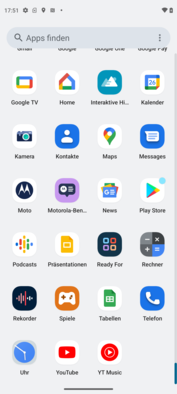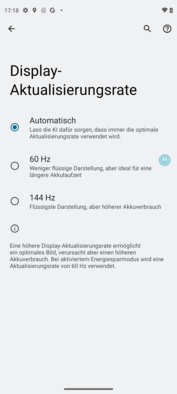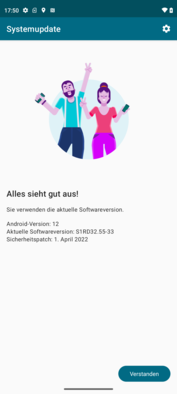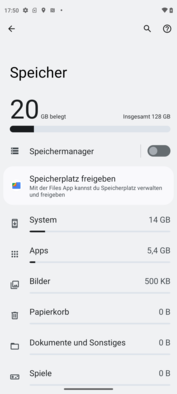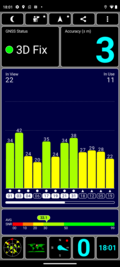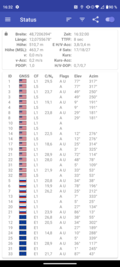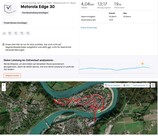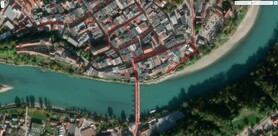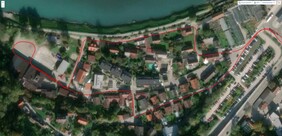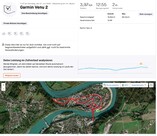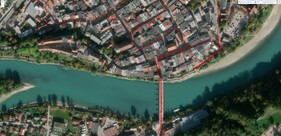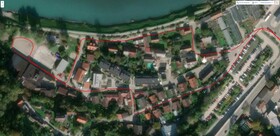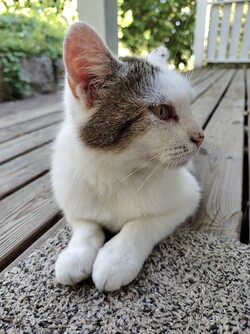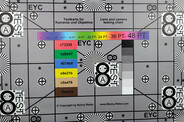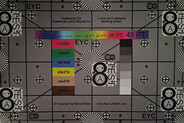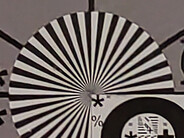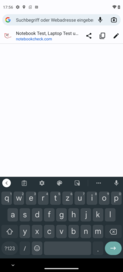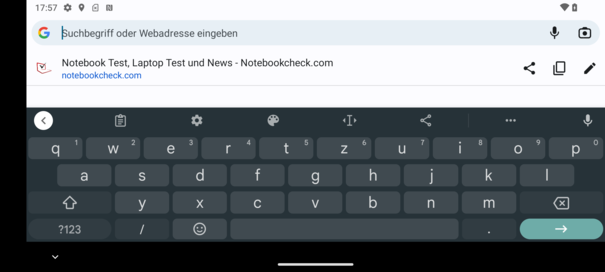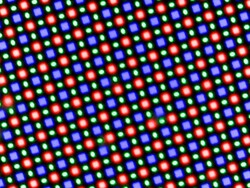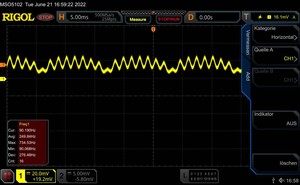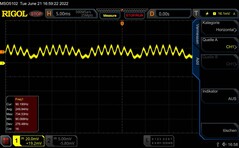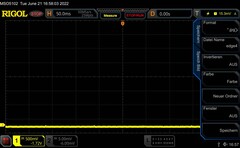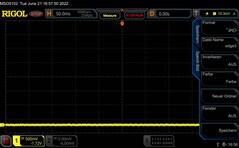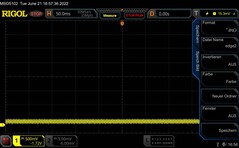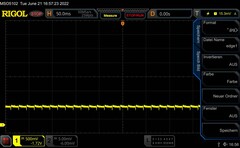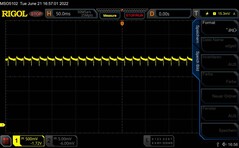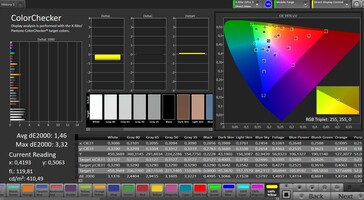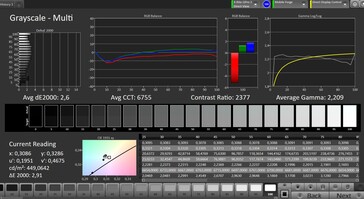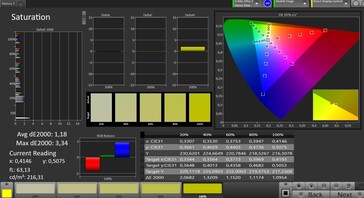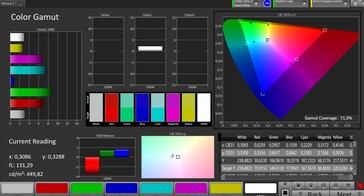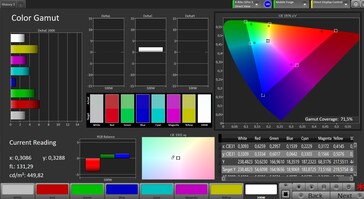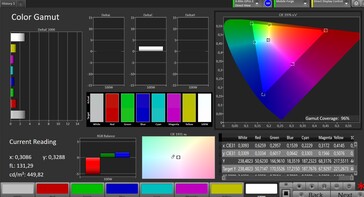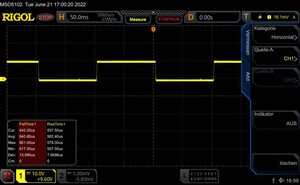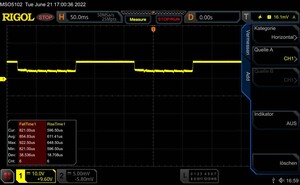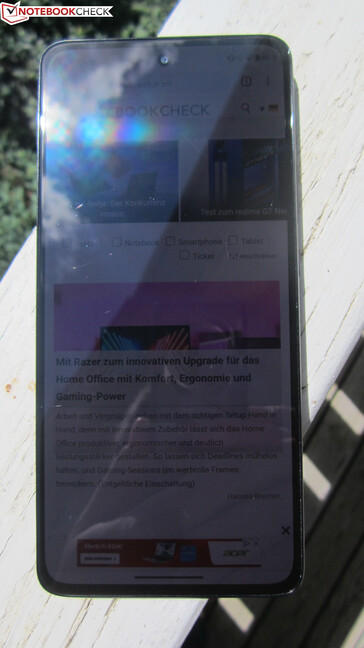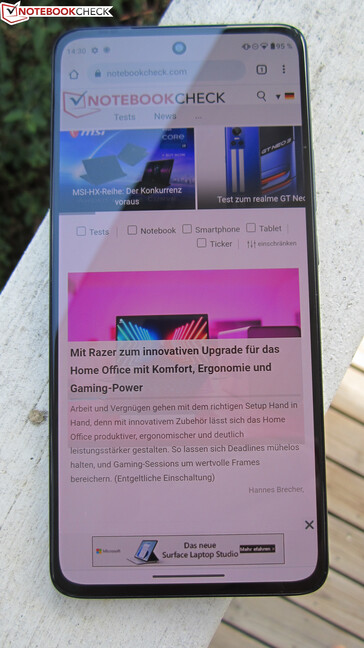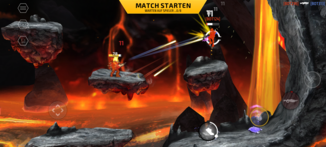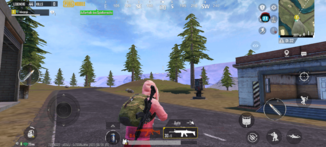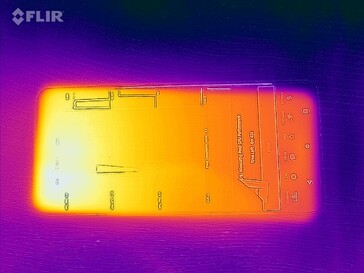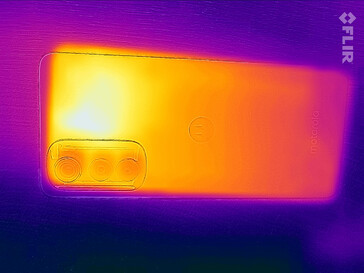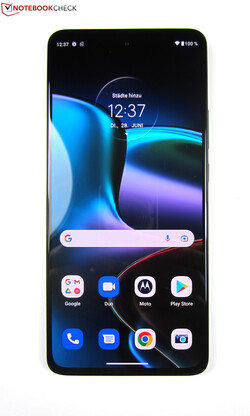Motorola Edge 30 smartphone review: Featherweight with 144 Hz display
After Motorola relaunched its mid- and upper-range Edge series last year, the third generation is now already in the starting blocks. This currently consists of the top model, the Edge 30 Pro, and its mid-range sibling, the Edge 30. An entry-level model, the Edge 30 Lite, will also be added soon.
As the "mid-range" variant of the Edge 30 series, the Motorola Edge 30 is the link between the Edge 30 Lite and Edge 30 Pro in terms of price and performance, which should make it the most interesting for many buyers.
Like the Edge 20, the Edge 30 again makes use of a 144 Hz display and the fast mid-range Snapdragon 778G+ 5G SoC. The camera module, on the other hand, has been completely revamped and now uses a 50 MP lens for both the main and ultra-wide-angle cameras. The Edge 30 also claims to be the thinnest 5G smartphone currently on the market. Whether this is enough to beat the competition will be revealed in the following review.
Possible Competitors in Comparison
Rating | Date | Model | Weight | Drive | Size | Resolution | Price |
|---|---|---|---|---|---|---|---|
| 86.4 % v7 (old) | 07 / 2022 | Motorola Edge 30 SD 778G+ 5G, Adreno 642L | 155 g | 128 GB UFS 3.1 Flash | 6.50" | 2400x1080 | |
| 85.3 % v7 (old) | 12 / 2021 | Huawei Nova 9 SD 778G 5G, Adreno 642L | 175 g | 128 GB UFS 3.1 Flash | 6.57" | 2340x1080 | |
| 85.5 % v7 (old) | 12 / 2021 | Honor 50 SD 778G 5G, Adreno 642L | 175 g | 256 GB UFS 2.1 Flash | 6.57" | 2340x1080 | |
| 84.2 % v7 (old) | 11 / 2021 | Motorola Edge 20 SD 778G 5G, Adreno 642L | 163 g | 128 GB UFS 2.1 Flash | 6.70" | 2400x1080 | |
| 83.4 % v7 (old) | 06 / 2022 | Samsung Galaxy A53 Exynos 1280, Mali-G68 MP4 | 189 g | 128 GB UFS 2.1 Flash | 6.50" | 2400x1080 | |
| 86.4 % v7 (old) | 12 / 2021 | Xiaomi 11 Lite 5G NE SD 778G 5G, Adreno 642L | 158 g | 128 GB UFS 2.2 Flash | 6.55" | 2400x1080 |
Case: Lightweight and slim plastic chassis
With a thickness of 6.8 millimeters, the Edge 30 is two millimeters thinner than its predecessor. But this does not include the camera unit, which protrudes a few millimeters more from the case than in the Edge 20. As a result, the Edge 30 wobbles back and forth on the table, which cannot be completely eliminated with the included protective cover.
The Edge 30 surprises with a featherweight of just 155 grams, making it significantly lighter than competitors such as the 6.5-inch Samsung Galaxy A53 5G, which weighs over 30 grams more. The combination of slim casing and low weight makes the Edge 30 a very practical smartphone which, at the same time, does not feel fragile.
Motorola clads its mid-range smartphone in a sturdy case with a display made of Gorilla Glass 3. The back is made of smooth plastic with a matte surface finish that shimmers in slightly different shades of color depending on lighting conditions. This looks sleek, but also makes the back cover quite susceptible to fingerprints.
The Edge 30 is available in the color variants "Meteor Grey", "Aurora Green" and "Supermoon Silver". The smartphone is IP52 certified and thus dust- and water resistant.
Equipment: 8 GB of RAM and 128 GB of storage
The Edge 30 is currently offered in two configurations: 8 GB of LPDDR5 RAM and 128 GB UFS 3.1 storage (8/128 GB) or 8/256. The availability and prices of these depend on your location (see "Price and Availability" at the end of this review for further details), although a cursory examination reveals that the former (8/128) appears to be the most common configuration available (in some cases, only 8/256 is available, such as in Brazil). The storage cannot be expanded due to the lack of a microSD slot. Of the 128 GB, 98 GB remains on the device upon purchase.
The Motorola Edge 30 does not have a jack socket, so the USB-C port has to be used for connecting wired headphones or speakers. In addition to NFC, the smartphone supports Bluetooth 5.2. Since DRM WideVine L1 is also included, the Edge 30 can also stream content in HD quality.
Software: Android 12 and updates for three years
The Edge 30 uses a near-stock Android 12, which Motorola has provided with its Moto app. This allows users to adjust the layout, fonts and gesture controls, among other things. At the time of review (end of June), the Android security patches were still from April 1, 2022 and thus no longer quite up to date.
A nice addition is the "Ready For" capability of the Edge 30, which allows the wireless mirroring of content on a TV (or monitor) and also activates a special desktop interface. However, only the Edge 30 Pro supports a "Ready For" cable connection.
Motorola has pledged to supply Edge 30 users with Android security updates until May 2025, a total of 3 years from its release date in May 2022. Android 13 is already planned for the smartphone and a further upgrade to Android 14 is also promised.
Communication & GNSS: Fast WLAN and accurate positioning
Thanks to twenty two 4G bands and thirteen 5G bands, Motorola's Edge 30 covers a broad frequency spectrum, so users should have mobile reception at almost any location. Provided a suitable router like our Asus ROG Rapture GT-AXE11000 reference model is used, the 6.5-incher can communicate in local networks via WiFi 6E.
The Edge 30 scores with very stable transfer rates in the 6 GHz band and also delivers very good transfer rates of around 950 MBit/s in both the send and receive directions. Although it does not fully exploit the potential of its WiFi 6E modem, the given performance is enough to beat all comparison devices in terms of WLAN speed.
| Networking | |
| iperf3 receive AXE11000 | |
| Average of class Smartphone (52 - 1721, n=176, last 2 years) | |
| Samsung Galaxy A53 | |
| iperf3 transmit AXE11000 | |
| Average of class Smartphone (49.8 - 1828, n=176, last 2 years) | |
| Samsung Galaxy A53 | |
| iperf3 transmit AXE11000 6GHz | |
| Average of class Smartphone (508 - 1945, n=94, last 2 years) | |
| Motorola Edge 30 | |
| iperf3 receive AXE11000 6GHz | |
| Average of class Smartphone (451 - 1870, n=94, last 2 years) | |
| Motorola Edge 30 | |
| iperf3 transmit AX12 | |
| Honor 50 | |
| Xiaomi 11 Lite 5G NE | |
| Motorola Edge 20 | |
| Huawei Nova 9 | |
| iperf3 receive AX12 | |
| Motorola Edge 20 | |
| Honor 50 | |
| Xiaomi 11 Lite 5G NE | |
| Huawei Nova 9 | |
Localization of the Edge 30 takes place via the GPS, Glonass and Galileo satellite networks. Outdoors, this functions fairly rapidly and with an accuracy of up to 3 meters. Indoors, this is a little slower, but almost just as accurate at 4 meters.
Motorola passes the practical test with flying colors, for the Edge 30 records our bike ride almost as accurately as the Garmin Venu 2. The smartphone is thus very well suited for navigation tasks.
Telephony & Voice Quality
The Edge 30 delivers good voice quality. Voices were clear and intelligible for both the speaker and receiver during our test calls to mobile and landlines. Intelligibility remains high even when we communicate via the loudspeaker and the hands-free kit. VoLTE and VoWiFi are supported.
Entering the code *#07# in the phone app reveals the smartphone's SAR values. With a head SAR of 0.92 W/kg and a body SAR of 1.35 W/kg, these fall within an inconspicuous range in terms of radiation, so they are neither very low nor too high.
Cameras: Dual cameras with 50 MP each
Regarding the camera module, the Edge 30 takes a completely different approach to the Edge 20. Instead of a 108 MP main camera, a 16 MP ultra-wide-angle camera and an 8 MP telephoto lens, the successor uses two 50 MP cameras that are supported by a 2 MP depth sensor. There is also an optical image stabilizer in the main camera.
The 50 MP cameras use pixel binning to combine 4 adjacent pixels into one. If desired, you can also use full resolution in "Ultra-Res" mode. The Edge 30 Pro uses the same camera setup.
In daylight, the Edge 30 takes sharp and detailed photos with vivid colors. Subjects can be magnified via a 10x digital zoom, but this produces quite washed-out results. Only at a lower magnification level of around 5x does image quality then become satisfactory. At nighttime, the Edge 30 still captures plenty of detail, but also brightens up colors too much, which do not appear so natural.
The 50 MP ultra-wide-angle camera is a real exception in the mid-range and takes almost as good photos as the main camera, even if they have a slightly lower contrast overall. The images also remain relatively sharp at the edges, but also display visible image noise and chromatic aberrations. The ultra wide-angle camera is also used for the macro shots.
Videos can be recorded with both the main camera and ultra-wide-angle camera in 4K at 30 FPS, whereby HDR10+ can then also be used. Image quality is solid overall. Switching between the two lenses during recording is only possible in Full HD.
The selfie camera has a resolution of 32 MP and offers decent picture quality for video chats and snapshots. Like the main camera, it can record videos in a maximum of 4K with HDR10+, but the electronic image stabilization only works in Full HD resolution.
Image comparison
Choose a scene and navigate within the first image. One click changes the position on touchscreens. One click on the zoomed-in image opens the original in a new window. The first image shows the scaled photograph of the test device.
Tageslicht-Aufnahme 1Tageslicht-Aufnahme 2UltraweitwinkelLowlight-AufnahmeOur test lab shows that the camera is able to reproduce colors fairly accurately in optimal lighting conditions, with the exception of darker green tones. Even at 1 lux of residual light, accuracy remains high and all details of the test chart can still be clearly seen.
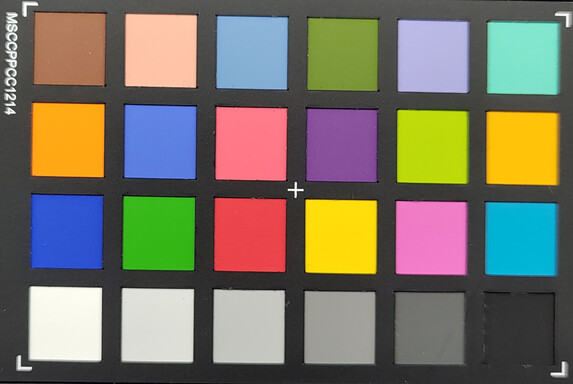
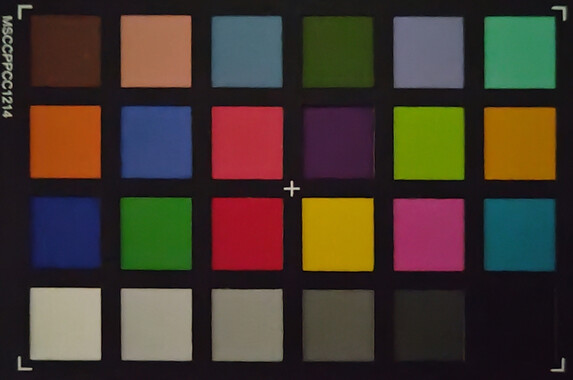
Accessories & Warranty: 33-watt power supply included
Upon purchase of the Edge 30, buyers receive a 33-watt power adapter, a USB cable (type A to C), a SIM tool, a transparent protective cover as well as a quick-start guide and warranty information. Buyers can stock up on accessories such as headsets and protective cases in the Motorola shop.
The Motorola Edge 30 comes with a 24-month warranty in Germany. This may vary in other countries and other regions, to be sure to double check with your supplier before purchasing.
There is also the option of extending the warranty to 3 years with Moto Care insurance. Three different service levels are available, the prices of which are dependent on your location.
Input Devices & Operation: Responsive 144 Hz screen
The 144 Hz screen of Motorola's Edge 30 allows for smooth scrolling through menus and websites. Inputs are implemented without any noticeable delay, making operation very fluid.
The fingerprint sensor underneath the display unlocks the smartphone quickly and reliably. Face recognition is used as the second biometric authentication method. It is software-based and thus not quite as secure as the fingerprint sensor, but it works quickly and achieves an equally high recognition rate in sufficient ambient light.
Display: Bright AMOLED-Panel with HDR10+
Compared to the Edge 20, the Edge 30 also uses a 2400 x 1080 pixel AMOLED screen, but with two important differences. The pixel density increases to 404 PPI due to the decreased screen diagonal from 6.7 to 6.5 inches, making the display even sharper. Moreover, Motorola has given the successor a much brighter screen.
The AMOLED screen of the Edge 30 achieves an average brightness of around 630 cd/m², which is a clear increase compared to the Edge 20's maximum brightness of 497 cd/m². Despite HDR10+ support, HDR effects are still limited in the Edge 30 because the screen cannot achieve more than 655 cd/m². Among the comparison devices, the Samsung Galaxy A53 5G and the Xiaomi 11 Lite 5G NE, for example, show that the brightness can be even better.
The AMOLED panel of the Edge 30 also uses pulse width modulation (PWM) for brightness control. The PWM flickering of 250 Hz is in a relatively low range and should not bother many sensitive users. A DC dimming switch is also available in the display settings as "Prevent flickering".
| |||||||||||||||||||||||||
Brightness Distribution: 92 %
Center on Battery: 632 cd/m²
Contrast: ∞:1 (Black: 0 cd/m²)
ΔE ColorChecker Calman: 1.46 | ∀{0.5-29.43 Ø4.77}
ΔE Greyscale Calman: 2.6 | ∀{0.09-98 Ø5}
96% sRGB (Calman 2D)
Gamma: 2.209
CCT: 6755 K
| Motorola Edge 30 AMOLED, 2400x1080, 6.5" | Huawei Nova 9 OLED, 2340x1080, 6.6" | Honor 50 OLED, 2340x1080, 6.6" | Motorola Edge 20 OLED, 2400x1080, 6.7" | Samsung Galaxy A53 AMOLED, 2400x1080, 6.5" | Xiaomi 11 Lite 5G NE AMOLED, 2400x1080, 6.6" | |
|---|---|---|---|---|---|---|
| Screen | 3% | -36% | -27% | 3% | 32% | |
| Brightness middle (cd/m²) | 632 | 621 -2% | 731 16% | 479 -24% | 718 14% | 797 26% |
| Brightness (cd/m²) | 630 | 632 0% | 722 15% | 480 -24% | 730 16% | 800 27% |
| Brightness Distribution (%) | 92 | 96 4% | 97 5% | 94 2% | 92 0% | 97 5% |
| Black Level * (cd/m²) | ||||||
| Colorchecker dE 2000 * | 1.46 | 1.7 -16% | 3.1 -112% | 2.06 -41% | 1.62 -11% | 0.9 38% |
| Colorchecker dE 2000 max. * | 3.32 | 2.8 16% | 5.8 -75% | 4.54 -37% | 4.21 -27% | 2 40% |
| Greyscale dE 2000 * | 2.6 | 2.2 15% | 4.2 -62% | 3.5 -35% | 2 23% | 1.1 58% |
| Gamma | 2.209 100% | 2.17 101% | 2.19 100% | 2.205 100% | 2.156 102% | 2.26 97% |
| CCT | 6755 96% | 6806 96% | 6818 95% | 6794 96% | 6545 99% | 6397 102% |
* ... smaller is better
Screen Flickering / PWM (Pulse-Width Modulation)
| Screen flickering / PWM detected | 250 Hz | ||
The display backlight flickers at 250 Hz (worst case, e.g., utilizing PWM) . The frequency of 250 Hz is relatively low, so sensitive users will likely notice flickering and experience eyestrain at the stated brightness setting and below. In comparison: 53 % of all tested devices do not use PWM to dim the display. If PWM was detected, an average of 8084 (minimum: 5 - maximum: 343500) Hz was measured. | |||
Messreihe mit fixer Zoomstufe und unterschiedlichen Helligkeitseinstellungen
In the preset "Saturated" image mode, the Edge 30 reproduces colors strongly, but neglects color fidelity. This is remedied when the second image mode "Natural" is selected. Grayscale (Delta-E 2.6) and color (Delta-E 1.46) values then fall in the ideal range, as does the color temperature. RGB balance and gamma are also almost perfect. The screen is able to cover just over 71% of both the AdobeRGB and DCI-P3 color spaces.
Display Response Times
| ↔ Response Time Black to White | ||
|---|---|---|
| 11 ms ... rise ↗ and fall ↘ combined | ↗ 6 ms rise | |
| ↘ 5 ms fall | ||
| The screen shows good response rates in our tests, but may be too slow for competitive gamers. In comparison, all tested devices range from 0.1 (minimum) to 240 (maximum) ms. » 28 % of all devices are better. This means that the measured response time is better than the average of all tested devices (20.2 ms). | ||
| ↔ Response Time 50% Grey to 80% Grey | ||
| 14 ms ... rise ↗ and fall ↘ combined | ↗ 8 ms rise | |
| ↘ 6 ms fall | ||
| The screen shows good response rates in our tests, but may be too slow for competitive gamers. In comparison, all tested devices range from 0.165 (minimum) to 636 (maximum) ms. » 27 % of all devices are better. This means that the measured response time is better than the average of all tested devices (31.6 ms). | ||
Performance: Solid performance thanks to the Snapdragon 778G+
The Edge 30 uses the Snapdragon 778G+ 5G, which falls in the upper mid-range in terms of performance. Motorola is in good company with its eight-core SoC, since its sister model, the Snapdragon 778G 5G, is a popular choice in this price segment and also powers all other comparison devices (with the exception of the Samsung Galaxy A53 5G). Since the Snapdragon 778G+ 5G runs only slightly faster, the benchmark results are correspondingly homogeneous.
Like its Snapdragon siblings, the Edge 30 delivers very solid everyday performance and also has enough power to run current games smoothly. The Samsung Galaxy A53 5G is a bit slower across the board with its Exynos 1280.
| CrossMark - Overall | |
| Average of class Smartphone (187 - 2722, n=122, last 2 years) | |
| Average Qualcomm Snapdragon 778G+ 5G (730 - 760, n=3) | |
| Motorola Edge 30 | |
| Xiaomi 11 Lite 5G NE | |
| Samsung Galaxy A53 | |
| AImark - Score v2.x | |
| Motorola Edge 20 | |
| Average Qualcomm Snapdragon 778G+ 5G (5777 - 139804, n=3) | |
| Motorola Edge 30 | |
| Samsung Galaxy A53 | |
| Xiaomi 11 Lite 5G NE | |
| GFXBench (DX / GLBenchmark) 2.7 | |
| T-Rex Onscreen | |
| Motorola Edge 20 | |
| Honor 50 | |
| Motorola Edge 30 | |
| Xiaomi 11 Lite 5G NE | |
| Samsung Galaxy A53 | |
| Huawei Nova 9 | |
| 1920x1080 T-Rex Offscreen | |
| Motorola Edge 30 | |
| Motorola Edge 20 | |
| Honor 50 | |
| Xiaomi 11 Lite 5G NE | |
| Huawei Nova 9 | |
| Samsung Galaxy A53 | |
| GFXBench 3.0 | |
| on screen Manhattan Onscreen OGL | |
| Motorola Edge 30 | |
| Motorola Edge 20 | |
| Xiaomi 11 Lite 5G NE | |
| Honor 50 | |
| Huawei Nova 9 | |
| Samsung Galaxy A53 | |
| 1920x1080 1080p Manhattan Offscreen | |
| Motorola Edge 30 | |
| Xiaomi 11 Lite 5G NE | |
| Huawei Nova 9 | |
| Motorola Edge 20 | |
| Honor 50 | |
| Samsung Galaxy A53 | |
| GFXBench 3.1 | |
| on screen Manhattan ES 3.1 Onscreen | |
| Motorola Edge 30 | |
| Huawei Nova 9 | |
| Xiaomi 11 Lite 5G NE | |
| Motorola Edge 20 | |
| Honor 50 | |
| Samsung Galaxy A53 | |
| 1920x1080 Manhattan ES 3.1 Offscreen | |
| Motorola Edge 30 | |
| Xiaomi 11 Lite 5G NE | |
| Huawei Nova 9 | |
| Motorola Edge 20 | |
| Honor 50 | |
| Samsung Galaxy A53 | |
| GFXBench | |
| on screen Car Chase Onscreen | |
| Motorola Edge 30 | |
| Huawei Nova 9 | |
| Motorola Edge 20 | |
| Xiaomi 11 Lite 5G NE | |
| Honor 50 | |
| Samsung Galaxy A53 | |
| 1920x1080 Car Chase Offscreen | |
| Motorola Edge 30 | |
| Motorola Edge 20 | |
| Honor 50 | |
| Xiaomi 11 Lite 5G NE | |
| Huawei Nova 9 | |
| Samsung Galaxy A53 | |
| on screen Aztec Ruins High Tier Onscreen | |
| Motorola Edge 30 | |
| Huawei Nova 9 | |
| Honor 50 | |
| Xiaomi 11 Lite 5G NE | |
| Motorola Edge 20 | |
| Samsung Galaxy A53 | |
| 2560x1440 Aztec Ruins High Tier Offscreen | |
| Motorola Edge 30 | |
| Honor 50 | |
| Xiaomi 11 Lite 5G NE | |
| Huawei Nova 9 | |
| Motorola Edge 20 | |
| Samsung Galaxy A53 | |
| on screen Aztec Ruins Normal Tier Onscreen | |
| Motorola Edge 30 | |
| Huawei Nova 9 | |
| Xiaomi 11 Lite 5G NE | |
| Honor 50 | |
| Motorola Edge 20 | |
| Samsung Galaxy A53 | |
| 1920x1080 Aztec Ruins Normal Tier Offscreen | |
| Xiaomi 11 Lite 5G NE | |
| Motorola Edge 30 | |
| Honor 50 | |
| Huawei Nova 9 | |
| Motorola Edge 20 | |
| Samsung Galaxy A53 | |
The browser benchmarks here attest to the strength of the Motorola Edge 30. Websites are swiftly loaded and displayed.
| Jetstream 2 - 2.0 Total Score | |
| Average of class Smartphone (23.8 - 387, n=147, last 2 years) | |
| Motorola Edge 30 (Chrome 102.0.5005.125) | |
| Average Qualcomm Snapdragon 778G+ 5G (73.7 - 100.4, n=3) | |
| Motorola Edge 20 (Chrome 95) | |
| Xiaomi 11 Lite 5G NE (Chrome 96) | |
| Honor 50 (Chrome 96) | |
| Samsung Galaxy A53 (Chrome 101) | |
| Huawei Nova 9 (Huawei Browser 12.0.0.303) | |
| Speedometer 2.0 - Result 2.0 | |
| Average of class Smartphone (15.2 - 643, n=119, last 2 years) | |
| Motorola Edge 30 (Chrome 102.0.5005.125) | |
| Xiaomi 11 Lite 5G NE (Chrome 96) | |
| Motorola Edge 20 (Chome 95) | |
| Average Qualcomm Snapdragon 778G+ 5G (53.7 - 66.5, n=3) | |
| Samsung Galaxy A53 (Chome 101) | |
| WebXPRT 3 - Overall | |
| Average of class Smartphone (38 - 380, n=30, last 2 years) | |
| Motorola Edge 20 (Chrome 95) | |
| Motorola Edge 30 (Chrome 102.0.5005.125) | |
| Average Qualcomm Snapdragon 778G+ 5G (102 - 127, n=3) | |
| Xiaomi 11 Lite 5G NE (Chrome 96) | |
| Honor 50 (Chrome 96) | |
| Huawei Nova 9 (Huawei Browser 12.0.0.303) | |
| Samsung Galaxy A53 (Chrome 101) | |
| Octane V2 - Total Score | |
| Average of class Smartphone (2228 - 126661, n=194, last 2 years) | |
| Motorola Edge 30 (Chrome 102.0.5005.125) | |
| Xiaomi 11 Lite 5G NE (Chrome 96) | |
| Motorola Edge 20 (Chrome 95) | |
| Honor 50 (Chrome 96) | |
| Average Qualcomm Snapdragon 778G+ 5G (24488 - 32794, n=3) | |
| Samsung Galaxy A53 (Chrome 101) | |
| Huawei Nova 9 (Huawei Browser 12.0.0.303) | |
| Mozilla Kraken 1.1 - Total | |
| Samsung Galaxy A53 (Chrome 101) | |
| Huawei Nova 9 (Huawei Browser 12.0.0.303) | |
| Average Qualcomm Snapdragon 778G+ 5G (1236 - 1796, n=3) | |
| Honor 50 (Chrome 96) | |
| Motorola Edge 20 (Chrome 95) | |
| Motorola Edge 30 (Chrome 102.0.5005.125) | |
| Xiaomi 11 Lite 5G NE (Chrome 96) | |
| Average of class Smartphone (257 - 28190, n=154, last 2 years) | |
* ... smaller is better
The UFS 3.1 storage of the Edge 30 scores with high transfer rates and can read and write large amounts of data quickly. Compared to the UFS 2.1 memory of the predecessor, this is a significant performance increase.
| Motorola Edge 30 | Huawei Nova 9 | Honor 50 | Motorola Edge 20 | Samsung Galaxy A53 | Xiaomi 11 Lite 5G NE | Average 128 GB UFS 3.1 Flash | Average of class Smartphone | |
|---|---|---|---|---|---|---|---|---|
| AndroBench 3-5 | -16% | -15% | -30% | -34% | -28% | -4% | 51% | |
| Sequential Read 256KB (MB/s) | 1514.62 | 1030 -32% | 984 -35% | 1011 -33% | 510.1 -66% | 944 -38% | 1569 ? 4% | 2235 ? 48% |
| Sequential Write 256KB (MB/s) | 965.35 | 759 -21% | 609 -37% | 471.4 -51% | 486.7 -50% | 679 -30% | 768 ? -20% | 1871 ? 94% |
| Random Read 4KB (MB/s) | 241.72 | 229.6 -5% | 245.7 2% | 190.2 -21% | 229.9 -5% | 208.7 -14% | 244 ? 1% | 297 ? 23% |
| Random Write 4KB (MB/s) | 249.14 | 239.2 -4% | 280.2 12% | 210.6 -15% | 210.8 -15% | 178.8 -28% | 243 ? -2% | 343 ? 38% |
Gaming: 144 Hz is the exception
With its 144 Hz screen, stereo speakers, and Snapdragon 778G+ 5G with its Adreno 642L graphics chip, Motorola's Edge 30 has all the prerequisites for making gaming fun. The smartphone did not have any problems rendering current games smoothly under testing, even in high details.
However, the Edge 30 can hardly exploit the full potential of its 144 Hz screen, since only a few games are optimized for such high frame rates and usually set a specific upper FPS limit for energy-saving reasons. For example, Armajet does not actually have a frame rate limit, but only runs at a maximum of 60 Hz on the Edge 30. PUBG Mobile is limited to 30 FPS under testing, but practically never drops below that even at the "HD/High" setting. Subway Surfers manages up to 90 FPS.
Frame rates were determined with our Gamebench test tool.
Emissions - High surface temperatures, but no throttling
Temperature
Under testing, surface temperatures of the Edge 30 heat up to 48.5 °C. While this is not in the critical range, it may be a few degrees higher on hot summer days, thus resulting in eventual discomfort of use.
On the other hand, the high surface temperatures do not negatively impact performance. As 3DMark's Wild Life stress tests and GFXBench's battery test show, the Edge 30 can still max out its performance potential even after repeated test runs.
(-) The maximum temperature on the upper side is 46.5 °C / 116 F, compared to the average of 35.2 °C / 95 F, ranging from 21.9 to 247 °C for the class Smartphone.
(-) The bottom heats up to a maximum of 48.5 °C / 119 F, compared to the average of 34 °C / 93 F
(±) In idle usage, the average temperature for the upper side is 36.3 °C / 97 F, compared to the device average of 32.9 °C / 91 F.
3DMark Wild Life Stress Test
| 3DMark | |
| Wild Life Stress Test Stability | |
| Samsung Galaxy A53 | |
| Honor 50 | |
| Motorola Edge 20 | |
| Xiaomi 11 Lite 5G NE | |
| Motorola Edge 30 | |
| Wild Life Extreme Stress Test | |
| Honor 50 | |
| Motorola Edge 20 | |
| Xiaomi 11 Lite 5G NE | |
| Motorola Edge 30 | |
| Samsung Galaxy A53 | |
Speakers
The stereo speakers of the Edge 30 are quite treble-heavy and almost completely drown out the bass tones in the sound mix. But they reproduce speech very well and do not distort even when the volume is maxed out.
Wired headsets and speakers can be connected via USB-C. Bluetooth 5.2 is available for wireless audio devices. Common Bluetooth codecs such as aptX, aptX HD and aptX Adaptive are supported.
Motorola Edge 30 audio analysis
(+) | speakers can play relatively loud (84.6 dB)
Bass 100 - 315 Hz
(-) | nearly no bass - on average 21.2% lower than median
(±) | linearity of bass is average (9.1% delta to prev. frequency)
Mids 400 - 2000 Hz
(±) | higher mids - on average 7.3% higher than median
(±) | linearity of mids is average (7% delta to prev. frequency)
Highs 2 - 16 kHz
(+) | balanced highs - only 2.5% away from median
(+) | highs are linear (3.6% delta to prev. frequency)
Overall 100 - 16.000 Hz
(±) | linearity of overall sound is average (18.6% difference to median)
Compared to same class
» 21% of all tested devices in this class were better, 9% similar, 70% worse
» The best had a delta of 11%, average was 35%, worst was 134%
Compared to all devices tested
» 41% of all tested devices were better, 8% similar, 51% worse
» The best had a delta of 4%, average was 24%, worst was 134%
Motorola Edge 20 audio analysis
(+) | speakers can play relatively loud (84.5 dB)
Bass 100 - 315 Hz
(-) | nearly no bass - on average 22.4% lower than median
(±) | linearity of bass is average (11% delta to prev. frequency)
Mids 400 - 2000 Hz
(+) | balanced mids - only 3.8% away from median
(±) | linearity of mids is average (7.8% delta to prev. frequency)
Highs 2 - 16 kHz
(±) | higher highs - on average 8% higher than median
(±) | linearity of highs is average (7.5% delta to prev. frequency)
Overall 100 - 16.000 Hz
(±) | linearity of overall sound is average (20.3% difference to median)
Compared to same class
» 33% of all tested devices in this class were better, 9% similar, 57% worse
» The best had a delta of 11%, average was 35%, worst was 134%
Compared to all devices tested
» 52% of all tested devices were better, 8% similar, 40% worse
» The best had a delta of 4%, average was 24%, worst was 134%
Battery life: Short due to small battery
Power Consumption
The Edge 30 is rather restrained in terms of power consumption, only consuming an average of 1.2 watts when idle and an average of 3.6 watts under load. This makes it the most energy-efficient among all comparison devices.
In testing, the smartphone was recharged from 0 to 100 percent in 1:04 hours via the included 33-watt power adapter. The battery was 75% full after 40 minutes. Wireless charging is not supported on the Edge 30.
| Off / Standby | |
| Idle | |
| Load |
|
Key:
min: | |
| Motorola Edge 30 4020 mAh | Huawei Nova 9 4300 mAh | Honor 50 4300 mAh | Motorola Edge 20 4000 mAh | Samsung Galaxy A53 5000 mAh | Xiaomi 11 Lite 5G NE 4250 mAh | Average Qualcomm Snapdragon 778G+ 5G | Average of class Smartphone | |
|---|---|---|---|---|---|---|---|---|
| Power Consumption | -39% | -54% | -7% | -15% | -15% | -15% | -35% | |
| Idle Minimum * (Watt) | 0.9 | 0.96 -7% | 1.02 -13% | 1 -11% | 0.9 -0% | 0.78 13% | 1.067 ? -19% | 0.847 ? 6% |
| Idle Average * (Watt) | 1.2 | 2.47 -106% | 2.98 -148% | 1.3 -8% | 1.3 -8% | 1.97 -64% | 1.333 ? -11% | 1.448 ? -21% |
| Idle Maximum * (Watt) | 1.5 | 2.55 -70% | 3.11 -107% | 1.6 -7% | 1.6 -7% | 1.99 -33% | 1.7 ? -13% | 1.633 ? -9% |
| Load Average * (Watt) | 3.6 | 3.85 -7% | 3.59 -0% | 3.9 -8% | 5.7 -58% | 3.23 10% | 4.37 ? -21% | 6.96 ? -93% |
| Load Maximum * (Watt) | 7.1 | 7.43 -5% | 7.12 -0% | 7.2 -1% | 7.3 -3% | 7.08 -0% | 7.8 ? -10% | 11.3 ? -59% |
* ... smaller is better
Power Consumption: Geekbench (150 cd/m²)
Power Consumption: GFXBench (150 cd/m²)
Battery Life
The battery life is one of the few weaknesses of the Motorola Edge 30. With 4020 mAh, its battery is rather skimpy by Android standards, which is also not balanced out by the smartphone's energy efficiency.
With 10:38 hours of simulated web surfing and a little less than 17 hours of video playback, the Edge 30, like its Edge 20 predecessor, performs below average in the battery test and thus falls behind all other comparison devices. In everyday use, the Edge 30 should be able to last a day away from the power socket, but not much more.
| Motorola Edge 30 4020 mAh | Huawei Nova 9 4300 mAh | Honor 50 4300 mAh | Motorola Edge 20 4000 mAh | Samsung Galaxy A53 5000 mAh | Xiaomi 11 Lite 5G NE 4250 mAh | |
|---|---|---|---|---|---|---|
| Battery runtime | 3% | 42% | -3% | 24% | 6% | |
| Reader / Idle (h) | 26.7 | 25.7 -4% | 40.5 52% | 27.5 3% | ||
| H.264 (h) | 16.7 | 18.4 10% | 19.1 14% | 20.3 22% | ||
| WiFi v1.3 (h) | 10.6 | 10.9 3% | 15.1 42% | 11.9 12% | 14.8 40% | 11.8 11% |
| Load (h) | 4.5 | 3.1 -31% | 4.1 -9% | 3.9 -13% |
Pros
Cons
Verdict on the Motorola Edge 30
Motorola's Edge 30 is a good mid-range smartphone in an extra-slim case and a featherweight at 155 grams, ahead of the competition. Those looking for a particularly slim and light smartphone will find a suitable candidate in this 6.5-inch model.
Despite appearances, the Edge 30 is no lightweight in terms of performance. Thanks to a Snapdragon 778G+ 5G, 8 GB of RAM and 128 GB of storage, it is well-equipped for everyday use and somewhat faster than one of its main rivals, the Samsung Galaxy A53 5G. The Edge 30 also goes one step further with the 144 Hz frame rate of its AMOLED screen. Other plus points are the stock Android 12, the fast and stable WLAN, stereo speakers and a 50 MP camera that takes good photos in daylight.
The Motorola Edge 30 is a slim and light mid-range smartphone with a 144 Hz display and good performance, but somewhat short battery runtimes.
One of the main criticisms of the Edge 20 also apply to the Edge 30: battery runtimes are average at best. Users thus cannot expect the smartphone to always run for more than one day in real world use. Buyers also have to do without a microSD slot and the option of charging the Edge 30 wirelessly.
A good alternative to Motorola's Edge 30 is, for example, Samsung Galaxy A53 5G, which runs almost as fast, has a slightly brighter 120 Hz AMOLED panel and is also slightly cheaper. Even cheaper is the Xiaomi 11 Lite 5G NE, which runs on the Snapdragon 778G and uses a 90 Hz AMOLED screen.
Price and Availability
Similarly to the recently reviewed Motorola Moto G82 5G, the availability of the Edge 30 also appears to be sporadic. Buyers are thus advised to check directly on Motorola's website via their location, a list of which can be accessed here. After selecting your location, simply type Edge 30 in the search bar.
We found, for example, that the smartphone is already available in the UK, France, Columbia, India, Malaysia and Brazil (this list is not exhaustive). But the available configurations can vary; in some countries, only one (8/128 or 8/256) may be on offer. Some other countries also offer both configurations.
Motorola Edge 30
- 08/30/2022 v7 (old)
Manuel Masiero




